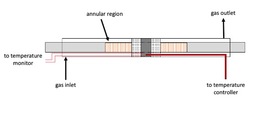Annular Photoreactor for Differential and Scaled-Up Photocatalysis
TECHNOLOGY NUMBER: 2022-325

OVERVIEW
External illumination allows for both LED and solar driven high temperature reactions- Scalable with improved mass transfer and temperature control
- Flexible light source to accommodate desired reaction
BACKGROUND
Photoreactors offer potential for solar driven industrial processes such as air and wastewater treatment, biomass conversion, hydrogen generation, and other chemical processes. Although annular photoreactors are known, most have been designed for liquid-phase chemistry and are not suited for solar applications as they are illuminated internally.
INNOVATION
Researchers at the University of Michigan have developed an annular photoreactor that avoids many of the issues that plague other high temperature photoreactors, in particular the commonly used Harrick reactor. Through both simulation and experimental comparison, the UM photoreactor has been demonstrated to provide effective mass transfer, uniform illumination with excellent light penetration, and better temperature measurement and control. The design is scalable and easily cleaned and maintained.
The UM reactor design has been shown to improve upon the residence time distribution and flow uniformity while minimizing channeling compared to a standard packed bed reactor of equivalent volume. To maximize the surface area of photocatalyst that is in direct contact with light, the thickness of the annular region containing the packed catalyst has been optimized and smaller catalyst particles are used. The reactor utilizes a thermocouple embedded directly in the catalyst bed to ensure temperature accuracy.
While the reactor built by UM was deliberately sized for bench scale studies, it was built with scalability in mind and should also be suitable for larger scale industrial photoprocesses. The annular design provides an opportunity for scale-up without loss of uniform and maximized illumination of the catalyst. By utilizing a quartz reactor body instead of stainless steel, stronger cleaning agents such as aqua regia and piranha solution may be used to contamination built up through extended use. Although designed with solar applications in mind, the photoreactor can be equipped with the user's external light source of choice, including high efficiency LEDs. In comparison to standard annular photoreactors that utilize internal illumination, the light source for the UM reactor is flexible and can be easily adjusted to accommodate the desired reaction.